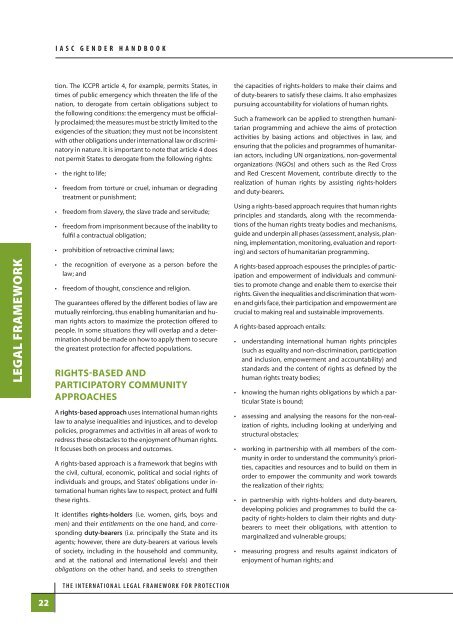Women, Girls, Boys and men - HumanitarianInfo.org
Women, Girls, Boys and men - HumanitarianInfo.org
Women, Girls, Boys and men - HumanitarianInfo.org
You also want an ePaper? Increase the reach of your titles
YUMPU automatically turns print PDFs into web optimized ePapers that Google loves.
LEGAL FRAMEWORK<br />
I A s c g e n D e r h A n D b o o k<br />
tion. The ICCPR article 4, for example, permits States, in<br />
times of public emergency which threaten the life of the<br />
nation, to derogate from certain obligations subject to<br />
the following conditions: the emergency must be officially<br />
proclaimed; the measures must be strictly limited to the<br />
exigencies of the situation; they must not be inconsistent<br />
with other obligations under international law or discriminatory<br />
in nature. It is important to note that article 4 does<br />
not permit States to derogate from the following rights:<br />
• the right to life;<br />
• freedom from torture or cruel, inhuman or degrading<br />
treat<strong>men</strong>t or punish<strong>men</strong>t;<br />
• freedom from slavery, the slave trade <strong>and</strong> servitude;<br />
• freedom from imprison<strong>men</strong>t because of the inability to<br />
fulfil a contractual obligation;<br />
• prohibition of retroactive criminal laws;<br />
• the recognition of everyone as a person before the<br />
law; <strong>and</strong><br />
• freedom of thought, conscience <strong>and</strong> religion.<br />
The guarantees offered by the different bodies of law are<br />
mutually reinforcing, thus enabling humanitarian <strong>and</strong> human<br />
rights actors to maximize the protection offered to<br />
people. In some situations they will overlap <strong>and</strong> a determination<br />
should be made on how to apply them to secure<br />
the greatest protection for affected populations.<br />
rIGHTS-BASEd And<br />
PArTICIPATory CommunITy<br />
APProACHES<br />
A rights-based approach uses international human rights<br />
law to analyse inequalities <strong>and</strong> injustices, <strong>and</strong> to develop<br />
policies, programmes <strong>and</strong> activities in all areas of work to<br />
redress these obstacles to the enjoy<strong>men</strong>t of human rights.<br />
It focuses both on process <strong>and</strong> outcomes.<br />
A rights-based approach is a framework that begins with<br />
the civil, cultural, economic, political <strong>and</strong> social rights of<br />
individuals <strong>and</strong> groups, <strong>and</strong> States’ obligations under international<br />
human rights law to respect, protect <strong>and</strong> fulfil<br />
these rights.<br />
It identifies rights-holders (i.e. wo<strong>men</strong>, girls, boys <strong>and</strong><br />
<strong>men</strong>) <strong>and</strong> their entitle<strong>men</strong>ts on the one h<strong>and</strong>, <strong>and</strong> corresponding<br />
duty-bearers (i.e. principally the State <strong>and</strong> its<br />
agents; however, there are duty-bearers at various levels<br />
of society, including in the household <strong>and</strong> community,<br />
<strong>and</strong> at the national <strong>and</strong> international levels) <strong>and</strong> their<br />
obligations on the other h<strong>and</strong>, <strong>and</strong> seeks to strengthen<br />
T H e I n T e R n AT I o n A l l e G A l F R A m e w o R k F o R P R o T e C T I o n<br />
the capacities of rights-holders to make their claims <strong>and</strong><br />
of duty-bearers to satisfy these claims. It also emphasizes<br />
pursuing accountability for violations of human rights.<br />
Such a framework can be applied to strengthen humanitarian<br />
programming <strong>and</strong> achieve the aims of protection<br />
activities by basing actions <strong>and</strong> objectives in law, <strong>and</strong><br />
ensuring that the policies <strong>and</strong> programmes of humanitarian<br />
actors, including UN <strong>org</strong>anizations, non-gover<strong>men</strong>tal<br />
<strong>org</strong>anizations (NGOs) <strong>and</strong> others such as the Red Cross<br />
<strong>and</strong> Red Crescent Move<strong>men</strong>t, contribute directly to the<br />
realization of human rights by assisting rights-holders<br />
<strong>and</strong> duty-bearers.<br />
Using a rights-based approach requires that human rights<br />
principles <strong>and</strong> st<strong>and</strong>ards, along with the recom<strong>men</strong>dations<br />
of the human rights treaty bodies <strong>and</strong> mechanisms,<br />
guide <strong>and</strong> underpin all phases (assess<strong>men</strong>t, analysis, planning,<br />
imple<strong>men</strong>tation, monitoring, evaluation <strong>and</strong> reporting)<br />
<strong>and</strong> sectors of humanitarian programming.<br />
A rights-based approach espouses the principles of participation<br />
<strong>and</strong> empower<strong>men</strong>t of individuals <strong>and</strong> communities<br />
to promote change <strong>and</strong> enable them to exercise their<br />
rights. Given the inequalities <strong>and</strong> discrimination that wo<strong>men</strong><br />
<strong>and</strong> girls face, their participation <strong>and</strong> empower<strong>men</strong>t are<br />
crucial to making real <strong>and</strong> sustainable improve<strong>men</strong>ts.<br />
A rights-based approach entails:<br />
• underst<strong>and</strong>ing international human rights principles<br />
(such as equality <strong>and</strong> non-discrimination, participation<br />
<strong>and</strong> inclusion, empower<strong>men</strong>t <strong>and</strong> accountability) <strong>and</strong><br />
st<strong>and</strong>ards <strong>and</strong> the content of rights as defined by the<br />
human rights treaty bodies;<br />
• knowing the human rights obligations by which a particular<br />
State is bound;<br />
• assessing <strong>and</strong> analysing the reasons for the non-realization<br />
of rights, including looking at underlying <strong>and</strong><br />
structural obstacles;<br />
• working in partnership with all members of the community<br />
in order to underst<strong>and</strong> the community’s priorities,<br />
capacities <strong>and</strong> resources <strong>and</strong> to build on them in<br />
order to empower the community <strong>and</strong> work towards<br />
the realization of their rights;<br />
• in partnership with rights-holders <strong>and</strong> duty-bearers,<br />
developing policies <strong>and</strong> programmes to build the capacity<br />
of rights-holders to claim their rights <strong>and</strong> dutybearers<br />
to meet their obligations, with attention to<br />
marginalized <strong>and</strong> vulnerable groups;<br />
• measuring progress <strong>and</strong> results against indicators of<br />
enjoy<strong>men</strong>t of human rights; <strong>and</strong>











